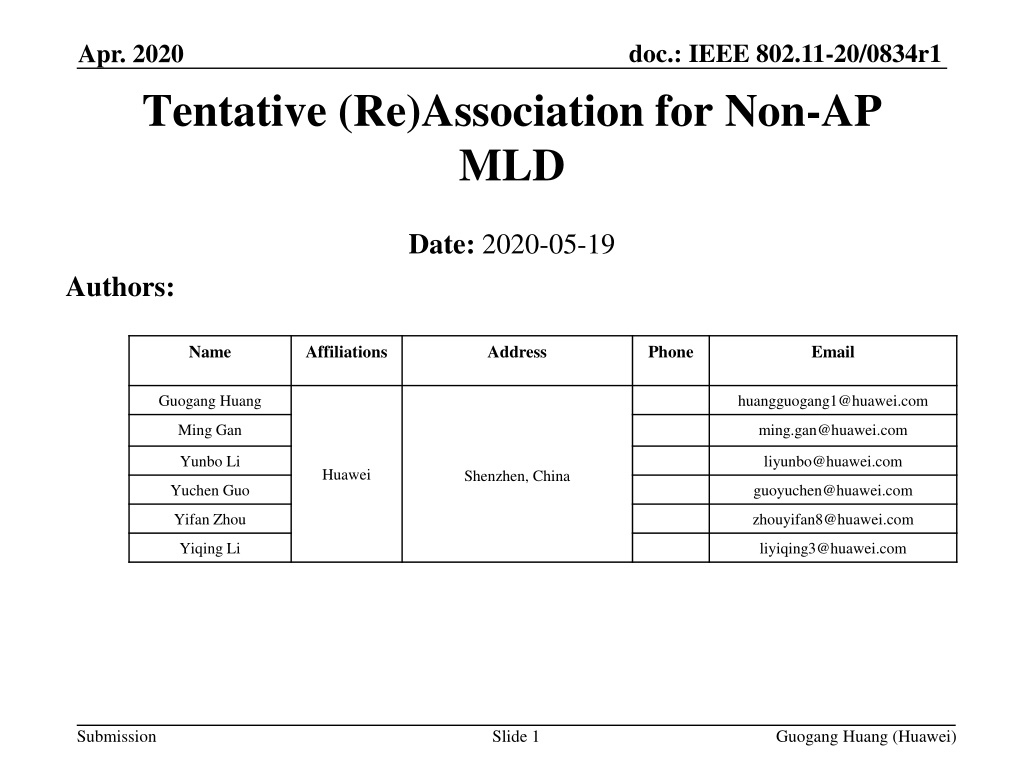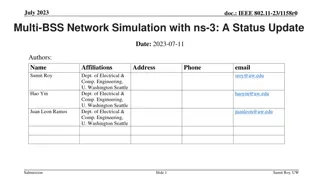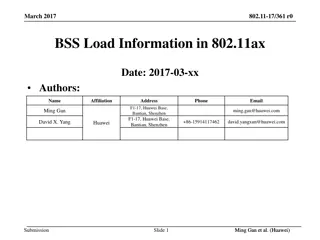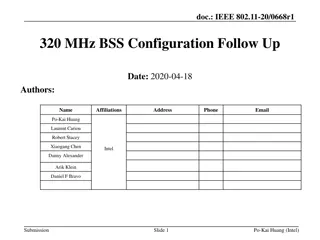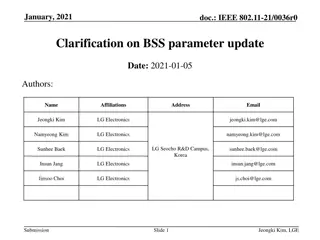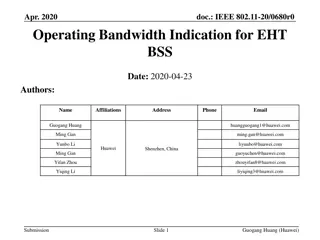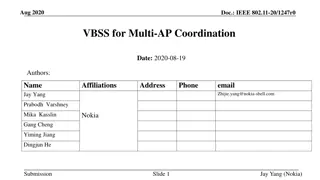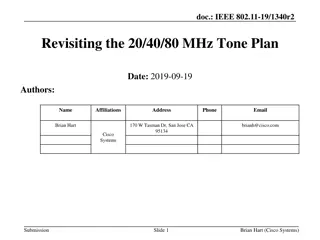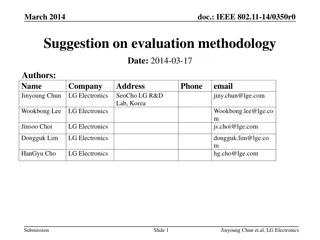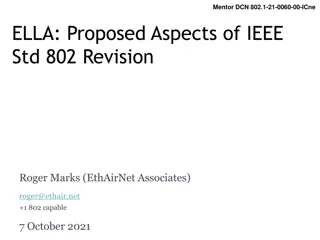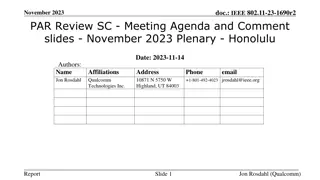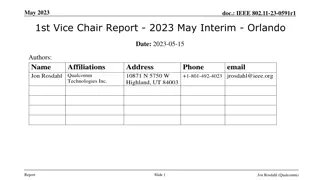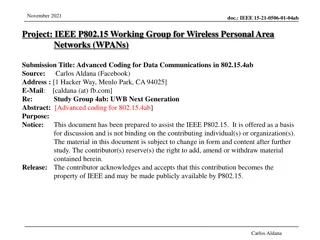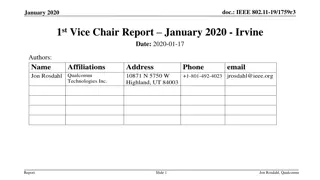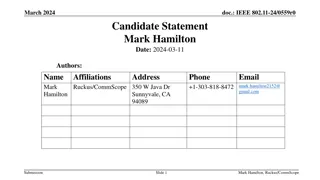IEEE 802.11-20/0834r1: Recap of Association and Fast BSS Transition
The document presents insights into tentative (re)association for non-AP MLDs, focusing on addressing data delivery interruptions during roaming and association with new access points. It covers necessary actions before data transfer, open system authentication, association operations, and fast BSS transitions. The Make Before Break scheme is highlighted to minimize data delivery gaps during roaming, emphasizing the use of power-save mechanisms. Additionally, the recap of association operations and fast BSS transition mechanisms under the IEEE 802.11 standard are discussed.
Download Presentation

Please find below an Image/Link to download the presentation.
The content on the website is provided AS IS for your information and personal use only. It may not be sold, licensed, or shared on other websites without obtaining consent from the author. Download presentation by click this link. If you encounter any issues during the download, it is possible that the publisher has removed the file from their server.
E N D
Presentation Transcript
doc.: IEEE 802.11-20/0834r1 Apr. 2020 Tentative (Re)Association for Non-AP MLD Date: 2020-05-19 Authors: Name Affiliations Address Phone Email Guogang Huang huangguogang1@huawei.com Ming Gan ming.gan@huawei.com Yunbo Li liyunbo@huawei.com Huawei Shenzhen, China Yuchen Guo guoyuchen@huawei.com Yifan Zhou zhouyifan8@huawei.com Yiqing Li liyiqing3@huawei.com Submission Slide 1 Guogang Huang (Huawei)
doc.: IEEE 802.11-20/0834r1 May 2020 Introduction For a STA with one single radio, the data delivery will be interrupted during a roaming until the re-association with a new AP is completely finished Contribution [1] first proposed the Make Before Break concept to reduce the gap in data delivery during a roaming in 2003 Exploit the power save mechanism to communicate to both old AP and new AP on the different channels Considering the fact of inter-frequency deployment and the limitation of only one single radio, the data delivery will be still interrupted during the tentative association with the new AP on a different channel This contribution will address how to implement the Make Before Break scheme under the MLD framework Submission Slide 2 Guogang Huang (Huawei)
doc.: IEEE 802.11-20/0834r1 May 2020 Recap-Association Operation STA AP AS Necessary Actions before data transfer 802.11 open system authentication Exchange Association Request/Response frames 802.1X authentication if needed Derived PMK 4-way handshake if needed Derived PTK and GTK Authentication 802.11 open system authentication Authentication Association Request Security parameter exchange: STA determines whether PSK or 802.1X authentication applies Association Response (Optional) EAP-Start EAP Request/Identity EAP Response/Identity Radius-Access-Request 802.1X authentication, if needed ... ... (PMK) Radius-Access-Accept EAP -Success Key Message 1 Key Message 2 4-Way Handshake, if needed Key Message 3 Key Message 4 Data Transfer Submission Slide 3 Guogang Huang (Huawei)
doc.: IEEE 802.11-20/0834r1 May 2020 Recap-Association Operation 802.11 Spec-2016. At any given instant, a STA is associated with no more than one AP. This allows the DS to determine a unique answer to the question, Which AP is serving STA X? Once an association is completed, a STA can make full use of a DS (via the AP) to communicate. DS-STA-NOTIFY.request primitive Update STA-AP Mapping info When to send DS-STA-NOTIFY.request primitive to the DS is not specifically defined in the current Spec. The reason may be that it doesn t matter for the single-radio client Submission Slide 4 Guogang Huang (Huawei)
doc.: IEEE 802.11-20/0834r1 May 2020 Recap-Fast BSS Transition AC/AS Maybe need to go to AC/AS to inquire PMKID info The data delivery is interrupted during this period. Submission Slide 5 Guogang Huang (Huawei)
doc.: IEEE 802.11-20/0834r1 May 2020 Recap-Make Before Break [1] Main Idea In order to minimize or eliminate any gap in data connectivity while roaming, it is proposed to let a STA make a partial connection with a new AP without dropping the connection with the old AP. Then the STA can negotiate with the new AP to set up the correct conditions for data connectivity, while still using the old AP for data connectivity. Once the correct conditions are set up, the new AP will trigger DS-STA-Notify.request to update STA-AP mapping info. The STA can then break the connection with the old AP, and the new AP start using the new AP for data connectivity. Submission Slide 6 Guogang Huang (Huawei)
doc.: IEEE 802.11-20/0834r1 May 2020 Recap-Make Before Break (Cont.) Split necessary actions before data transfer into two parts Part-1 action. All necessary actions except of STA-AP Mapping Notification e.g. Authentication, Association Request/Response, 802.1 X authentication, 4-way handshake to generate PTK and GTK, even BA agreement setup Note that existing EAPOL security communications are, strictly speaking, between the STA and the AP; the AP proxies these messages to the DS using its own MAC address, rather than the MAC address of the STA. In other word, during this period, communication is only allowed between STA and AP, but not from STA to DS directly. Part-2 action. STA-AP Mapping Notification by using the DS-STA- NOTIFY.request primitive to the DS Submission Slide 7 Guogang Huang (Huawei)
doc.: IEEE 802.11-20/0834r1 May 2020 Recap-Make Before Break (Cont.) Procedure of Make Before Break Step 1. STA sends a Tentative Association Request to the new AP. Step 2. Once the new AP responds to this request with a Tentative Association Response, the new AP and the STA would then be free to do Part-1 actions in order Step 3. STA sends a Complete Association Request to the new AP Step 4. In response, the new AP sends a Complete Association Response to the STA, and the STA-AP Mapping Notification to the DS. At this point, the association is complete, and the data delivery can go through the new AP. Submission Slide 8 Guogang Huang (Huawei)
doc.: IEEE 802.11-20/0834r1 May 2020 Make Before Break for Non-AP MLD In the following, we will give a possible procedure to describe the Make Before Break scheme under the MLD framework Step 1. Non-AP MLD disable one link with AP MLD 1, e.g. link 12, and the corresponding Reason Code is set to Tentative Association. Perhaps the TID-to-link mapping needs to be renegotiate with AP MLD 1 Step 2. STA 2@Non-AP MLD switches to CH2@2.4 GHz and sends a tentative Multi-link Association Request to AP 22@ AP MLD 2, while indicating the status of STA 1@Non-AP MLD is disable Step 3. AP MLD 2 replies a tentative Multi-link Association Response Step 4. Then Non-AP MLD is free to do any action of Part-1. Step 5. Non-AP MLD sends a frame (named STA-AP Mapping Notify) to trigger AP MLD 2 to sending DS-STA- NOTIFY.request to DS. Step 6. To minimize the gap in data delivery during a roaming, STA 1@non-AP MLD can switch to CH2@5 GHz at a certain point after AP MLD 2 sending DS-STA-NOTIFY.request to DS Submission Slide 9 Guogang Huang (Huawei)
doc.: IEEE 802.11-20/0834r1 May 2020 Make Before Break under MLD Framework Extension 1 For the roaming scenario, assuming that Non-AP MLD having 3 links, it can disable two links and initiate tentative re-association with two neighboring AP MLDs simultaneously. Finally, the Non- AP MLD would have to complete the association with only one AP MLD by sending STA-AP Mapping Notify frame. Pros. Increase the success rate of roaming considering the roaming may be rejected by candidate AP MLD for some reason Submission Slide 10 Guogang Huang (Huawei)
doc.: IEEE 802.11-20/0834r1 May 2020 Make Before Break under MLD Framework Extension 2 Similarly, for the initial association scenario, assuming that Non- AP MLD having 3 links, it can initiate tentative association with three neighboring AP MLDs simultaneously. Finally, the Non-AP MLD would have to complete the association with only one AP MLD by sending STA-AP Mapping Notify frame Pros. Increase the success rate of association considering the association may be rejected by AP MLD due to the specific admission control policy To avoid performing 802.1X authentication with multiple AP MLDs, non-AP MLD maybe send a new defined frame to initiate the 802.1X authentication via only one selected AP MLD Submission Slide 11 Guogang Huang (Huawei)
doc.: IEEE 802.11-20/0834r1 May 2020 Related Signaling Indication Signaling of link status Option 1(Prefer) . Non-AP MLD needs to explicitly indicate the status of each non- transmitted link in the Association Request frame Disable. For the disable link, maybe further indicate the corresponding Reason Code, e.g. power save, low RSSI, tentative association and so on. Enable. Option 2. use the TID-to-link mapping to implicitly indicate the status of each non- transmitted link in the Association Request frame Capability indication for tentative association Can be carried in Fast BSS Transition element , Mobility Domain element, RSNE or EHT Capabilities element Submission Slide 12 Guogang Huang (Huawei)
doc.: IEEE 802.11-20/0834r1 May 2020 Related Signaling Indication (Cont.) Signaling of tentative association In the conventional association, the 802.1X authentication, 4-way handshake and sending DS-STA- NOTIFY.request is automatically followed by successful (Re)association Request/Response exchange. In order to allow non-AP MLD simultaneously initiating tentative association with multiple AP MLDs, a new frame needs to be defined to trigger AP MLD sending DS-STA-NOTIFY.request, named as Non-AP MLD Trigger STA-AP Mapping Notify To differentiate with the conventional association, a signaling indication for tentative association needs to be carried in the Association Request frame One method is to define a new element, named Tentative Association element, which includes the following info Non-AP MLD Trigger STA-AP Mapping Notify. Set to 1, indicate the non-AP MLD will proactively send a frame to trigger the STA-AP Mapping Notify procedure Tentative Association Lifetime. Indicate the tentative association age-out time. Any communication between the non-AP MLD and AP MLD will reset the timer. Element ID Length Tentative Association Control Tentative Association Lifetime B2 B3 B7 B1 B0 Non-AP MLD Trigger STA-AP Mapping Notify Non-AP MLD Trigger 802.1X Authentication Notify (Optional) Non-AP MLD Trigger 4-way Handshake Notify (Optional) Reserved Submission Slide 13 Guogang Huang (Huawei)
doc.: IEEE 802.11-20/0834r1 May2020 Summary In this contribution, we describe that how to implement the Make before Break scheme [1] under the MLD framework. This scheme can really realize that the data delivery is not interrupted during the roaming by exploiting the multiple radios of non-AP MLD Submission Slide 14 Guogang Huang (Huawei)
doc.: IEEE 802.11-20/0834r1 May 2020 Reference [1] 11-03-0770-06-frfh-make-before-break Submission Slide 15 Guogang Huang (Huawei)
doc.: IEEE 802.11-20/0834r1 May 2020 Straw Poll 1 Do you support to standardize tentative (re)association scheme for the non-AP MLD? Y N A Submission Slide 16 Guogang Huang (Huawei)
doc.: IEEE 802.11-20/0834r1 May 2020 Annex 802.1X Authentication IEEE 802.16 Spec.-2016. A single IEEE 802.1X Port maps to one association, and each association maps to an IEEE 802.1X Port. Each association between a pair of STAs creates a unique pair of IEEE 802.1X Ports, and authentication takes place relative to those ports alone. An IEEE 802.1X Port consists of an IEEE 802.1X Controlled Port and an IEEE 802.1X Uncontrolled Port. The IEEE 802.1X Controlled Port is blocked from passing general data traffic between two STAs until an IEEE 802.1X authentication procedure completes successfully over the IEEE 802.1X Uncontrolled Port. Within IEEE Std 802.11, EAPOL PDUs are carried as MSDUs within one or more Data frames Submission Slide 17 Guogang Huang (Huawei)
